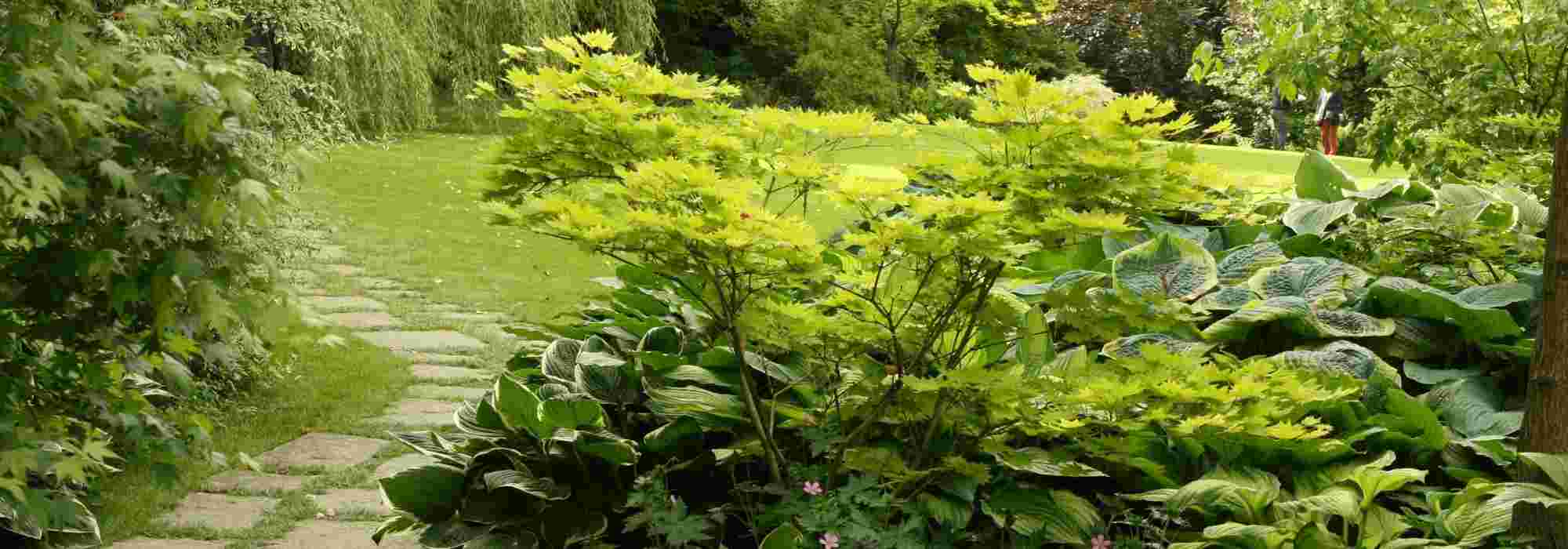
Shade Bush: Which Ones to Choose?
10 perfect bushes and our ideas for pairing them
Contents
Shade in the garden is not synonymous with gloom and boredom! While many perennials find ideal conditions there to thrive, a wide range of bushes also appreciate being protected from the sun’s scorching rays, especially in midsummer. Gardeners can find, under tree cover or in the shade cast by a building, a coolness to enjoy when temperatures soar. It’s an opportunity to create a welcoming space where foliage, colours and scents accompany afternoon naps as much as the seasons.
Here is a selection of 10 essential bushes for shade!
Japanese Aucuba, a champion beneath trees
Aucuba is a perfect bush for shade, especially for difficult-to-plant areas such as tree bases. It displays evergreen, thick and glossy foliage, green or variegated with yellow, which is particularly attractive in shade. It tolerates almost anything and even copes with deep shade. Can be planted both in mixed border and as hedge and its rounded habit ensures good presence all year. Flowering is fairly insignificant but, on female plants, is followed by numerous red then black fruits, decorative throughout winter.
Cultivation :
- soil ordinary, not too alkaline, rather fresh but well-drained.
- Growing in large pot on shaded terrace possible.
- Hardiness : -20 °C
Some interesting varieties :
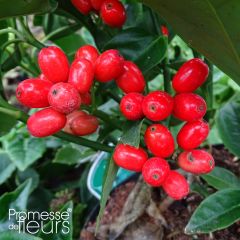
Aucuba Japonica Rozannie- Spotted Laurel
- Période de floraison May, June
- Hauteur à maturité 1,10 m
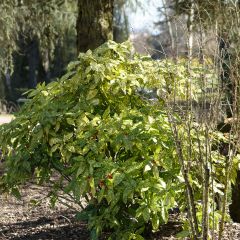
Aucuba japonica Crotonifolia- Spotted Laurel
- Période de floraison May, June
- Hauteur à maturité 1,80 m
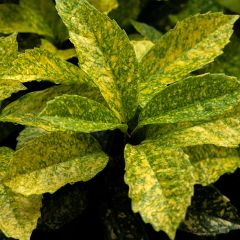
Aucuba japonica Golden King- Spotted Laurel
- Période de floraison May, June
- Hauteur à maturité 1,80 m
Ideas for pairing aucuba :
Aucuba pairs well, in mixed border or as hedge, with Aralia elata, Azaleas and Rhododendrons, Mexican orange blossom or with Enkianthus. In fresh soil, can also be combined with bamboos for exotic feel, or with camellias for more classic style. Scene will benefit from adding perennial plants. In dry shade, choose robust perennials such as Asarum, Acanthus, hardy geraniums. In fresher soil, opt for Japanese anemones, ferns, hostas or bleeding hearts.
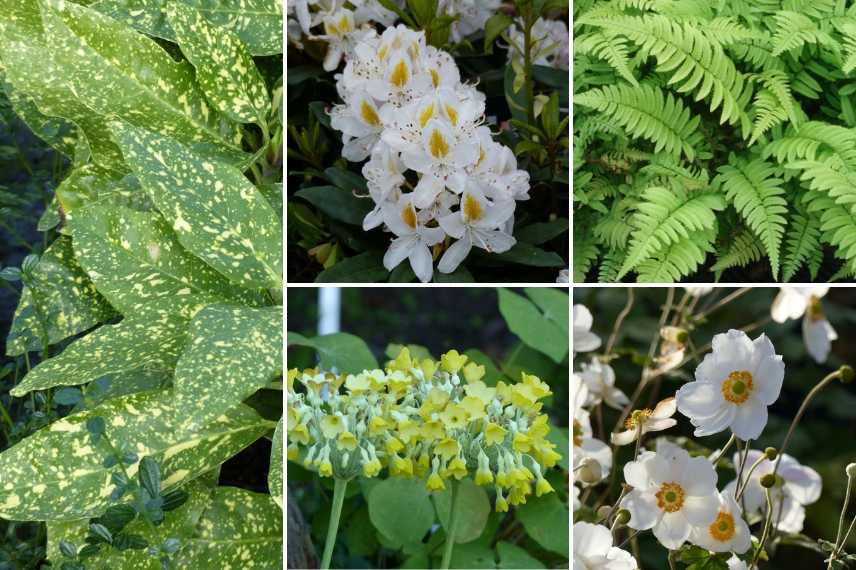
An idea for a combination in acidic, moist soil: Aucuba japonica ‘Variegata’, Rhododendron ‘Madame Masson’ for spring flowering, Dryopteris cycadina, Primula florindae to add colour in summer and Japanese anemone ‘Honorine Jobert’ to brighten autumn
→ For full information on Aucuba, see our plant sheet “Aucuba: planting, pruning and maintenance”
Hydrangea, Between Tradition and Modernity
Hydrangeas are a classic choice for shaded beds. Traditional Hydrangea macrophylla is well known, but there are very contemporary species and varieties with refined flowering. This is the case for Hydrangea aspera and serrata, which have small fertile flowers grouped in flattened umbels, surrounded by sterile pseudo-flowers. Hydrangea foliage is generally green, but cultivars with purple, bronze and even golden leaves exist. There are also climbing species that can scale their supports to over 10 metres!
Cultivation:
- acidic, light, humus-bearing and cool soil
- container growing on a shaded terrace is possible.
- Hardiness: variable — down to -10 °C for least hardy varieties.
Some interesting varieties:
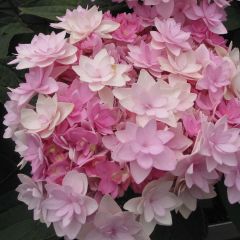
Hydrangea macrophylla You and Me Romance
- Période de floraison August to October
- Hauteur à maturité 1,20 m
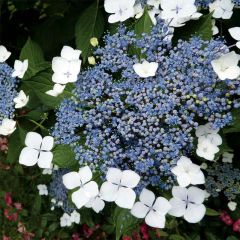
Hydrangea serrata Blue Bird - Mountain Hydrangea
- Période de floraison August to October
- Hauteur à maturité 1,20 m
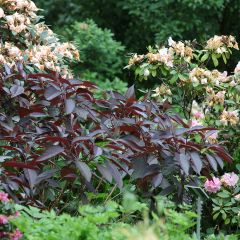
Hydrangea aspera Hot Chocolate
- Période de floraison August to October
- Hauteur à maturité 2 m
→ also discover, “Hydrangeas: 7 remarkable new introductions in 2019”
Ideas for pairing hydrangeas:
Make your hydrangea the centrepiece of your bed by pairing it with Holodiscus, potentillas, astilbes (in cool soil) or Hostas. Introduce lightness with the airy foliage of grasses that tolerate low light, or reinforce the ‘woodland’ effect with ferns. In not-too-dense shade and on a sizeable specimen, why not train a Clematis viticella to climb? Consider festooning trunks of neighbouring trees with a climbing Hydrangea or a Schizophragma, both of which echo hydrangea inflorescences.
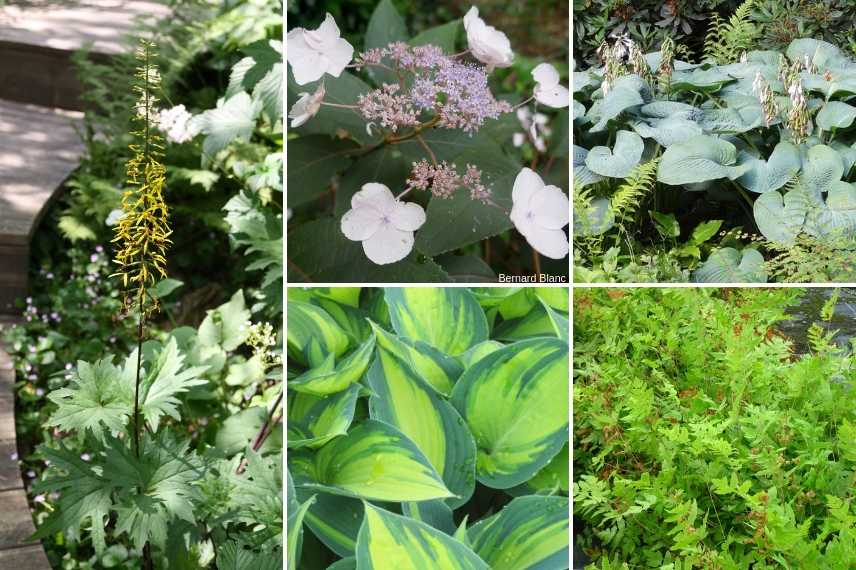
An idea for a pairing in cool shade: Ligularia przewalskii, Hydrangea aspera ‘Hot Chocolate’, Hosta ‘Big Daddy’, Hosta ‘June’ and Osmunda regalis ‘Purpurascens’
→ For everything you need to know, discover all care guides dedicated to hydrangeas
Mahonia, a resplendent bush in winter
Mahonia presents an original look with its upright habit and its strongly divided evergreen leaves. In shade, it brightens with yellow, sometimes orange, flowering that most often occurs in winter. Flowers, scented like lily of the valley, are followed by blue berries that extend its ornamental interest.
It is an architectural plant, very easy to to grow, offering many varieties, including ‘Soft Caress’, with long fine leaves, which will appeal to those who fear the prickly foliage of classic varieties.
Culture :
- light soil, even poor, neutral to slightly acidic. Mahonia aquifolium (and its cultivar ‘Apollo’ with dark foliage) tolerate some lime.
- Compact varieties are very easy to to grow in pots
- Hardiness : generally down to -20°C.
Some interesting varieties :
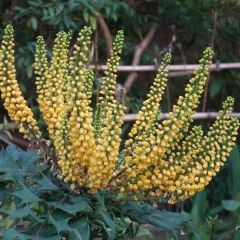
Mahonia x media Charity
- Hauteur à maturité 3,50 m
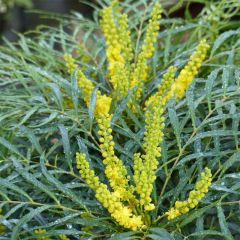
Mahonia Soft Caress - Mahonia hybrid
- Période de floraison October to December
- Hauteur à maturité 1,30 m
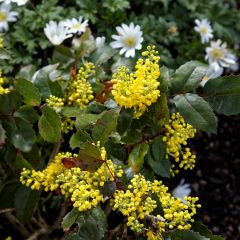
Mahonia aquifolium Apollo
- Période de floraison March, April
- Hauteur à maturité 80 cm
Our ideas to pair Mahonias :
Plant these Mahonias on a tapetum of ivy or of periwinkles, and combine them with ferns, bambous sacrés, together with Carex with fountain habit. Clumps of hellebores complete the scene in mid-winter, and some spring bulbs then take over.
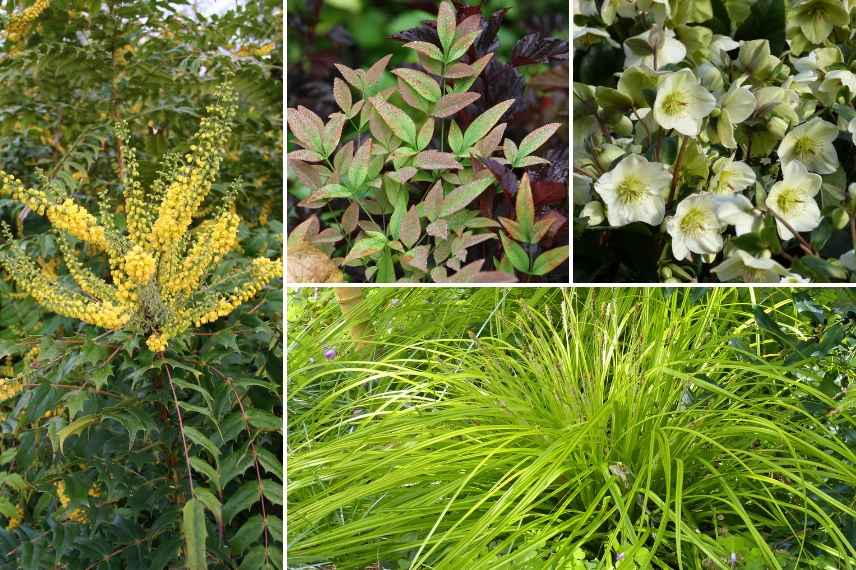
A bright pairing idea: Mahonia media ‘Charity’, Nandina ‘Obsessed Seika’, Helleborus ‘Ice n’ Roses White’ and Carex oshimensis ‘Everillo’
→ Find everything you need to know and our tips to to grow these beautiful bushes in our fact sheet : “Mahonia: plant, prune and maintain”
Read also
Hydrangeas: planting, pruning and careLeucothoé, chameleon foliage
Leucothoe is a must for shaded beds in heather soil. It is a bush described as “heather soil” with a compact habit and generally evergreen foliage, glossy and shiny. Its colours change with the seasons to display a deeper or paler purple in winter. In spring it bears a slightly scented flowering with small creamy‑white to pink‑tinged bell-shaped flowers reminiscent of lily‑of‑the‑valley or Pieris.
Cultivation :
- neutral to acidic soil, humus-bearing, light but remaining cool and well drained
- easy to grow in pots
- Hardiness: -20 °C but quite sensitive to spring freeze–thaw cycles and cold winds
Some interesting varieties :
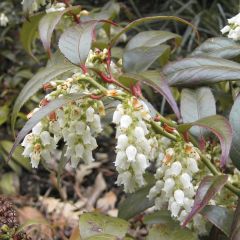
Leucothoe fontanesiana Scarletta
- Période de floraison June, July
- Hauteur à maturité 1,20 m
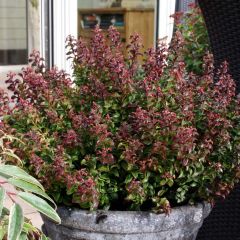
Leucothoe axillaris Twisting Red - Dog hobble
- Période de floraison May, June
- Hauteur à maturité 40 cm
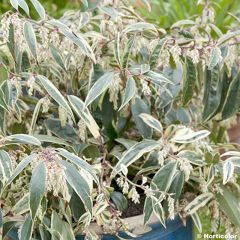
Leucothoe fontanesiana Whitewater
- Période de floraison May, June
- Hauteur à maturité 1,20 m
Our ideas for pairing Leucothoe :
Fond of acidic soils, Leucothoe therefore pairs well with many other heather soil bushes such as Rhododendrons and Azaleas, Hydrangeas, Camellias, Sarcococcas and Japanese maples . Complete the scene with tapetum of heathers and favour the graphic foliage of ferns or Hostas. Add drifts of spring bulbs such as crocuses, snowdrops, daffodils and don’t forget autumn ones like Colchicums (plant in summer!) if your bed is in light shade.
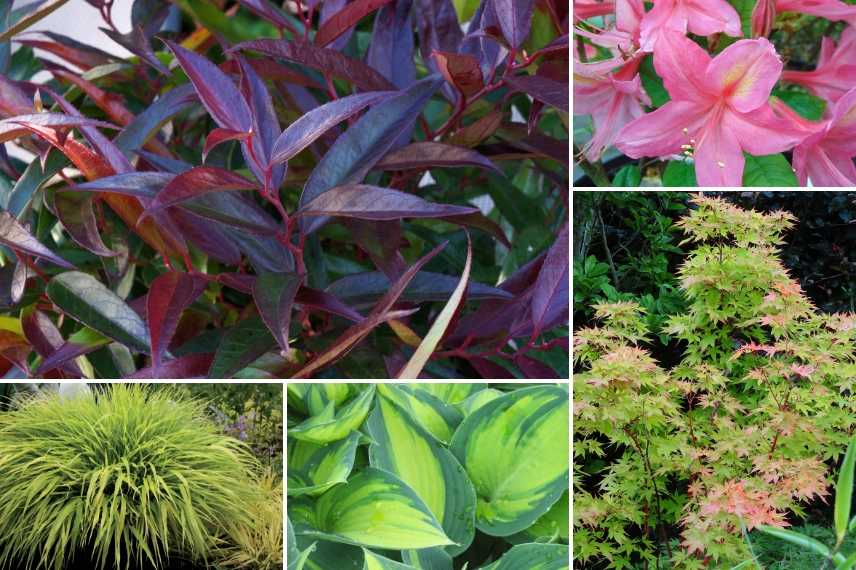
An idea for a combination in heather soil: Leucothoe keiskei ‘Burning Love’, Chinese Azalea ‘Jolie Madame’, Acer palmatum ‘Sangokaku’ (syn. ‘Senkaki’), Hosta ‘June’ and Hakonechloa macra ‘All Gold’
→ To find out more and succeed with this shade bush: “Leucothoe: planting, cultivation, pruning and maintenance”
Fatsia: tropical atmosphere in the garden
Very hardy and undemanding, Fatsia or Aralia is a fine shade bush. Its evergreen leaves, strongly palmate, give it a true exotic look. Foliage can be glossy green or splashed with cream, brightening even the darkest corners of garden or terrace. Its flowering in spherical white pom-poms occurs between July and September and recalls that of ivy. This is followed by fruiting into small black berries much appreciated by birds.
Culture :
- Good garden soil, not calcareous, cool in summer and not waterlogged in winter.
- Can be grown in a large container
- Hardiness: -15 °C in position protected from draughts and winds that can damage foliage
Some interesting varieties :
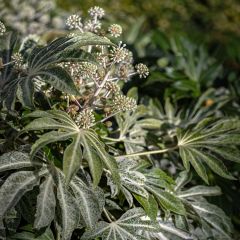
Fatsia japonica Spiders Web - Variegated False Aralia
- Période de floraison August to October
- Hauteur à maturité 2 m
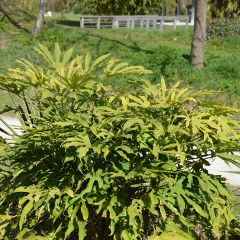
Fatsia polycarpa Green Fingers
- Période de floraison November, December
- Hauteur à maturité 2 m
Our ideas for combining Fatsia :
To accentuate tropical effect, pair Fatsia with other exotic foliage such as Tetrapanax, Acanthus, or Aspidistra, all set on a groundcover such as Asarum. In regions with milder winters, try Wheel tree, with its unusual flowering. Aralia’s Japanese feel can be emphasised by combining it with bamboos (bamboos described as ‘cespitose’ do not spread and do not require a rootstock barrier), Japanese maples, Hostas, Hakonechloas. At their feet, choose Chloranthus for its scented spring flowering, or Helxine for a mossy effect.
→ Read also: 7 ideas to pair Fatsia
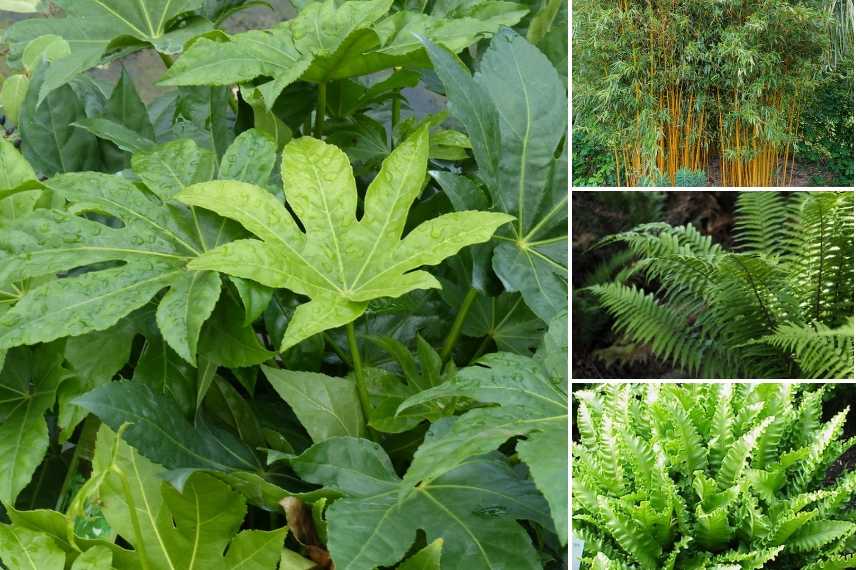
A tropical-inspired planting idea: Fatsia japonica, Phyllostachys aureosulcata ‘Aureocaulis’ (with rootstock barrier), Dryopteris wallichiana and Asplenium scolopendrium ‘Cristatum Group’
→ Read on the blog: “10 exotic and hardy plants for jungle garden”
Sarcococca for difficult spots
Bush with glossy, dense evergreen foliage and dense, which perfumes winter with very discreet flowers but a powerful scent. They are followed by berries red then black. Slow growth and moderate size, this bush with compact habit fits easily into the garden, even in areas where nothing grows, such as between the roots of trees. It spreads and occupies space without becoming invasive. Highly versatile, it resists pollution, diseases and is even suitable for dry shade. It also requires little maintenance.
Cultivation :
- Acid to neutral soils, fresh but well drained (tolerates difficult and dry soils, between roots)
- Very resistant (diseases, pollution, drought…)
- Hardy from -10°C to -15°C.
Some interesting varieties :
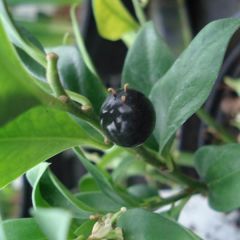
Sarcococca confusa
- Hauteur à maturité 1,50 m
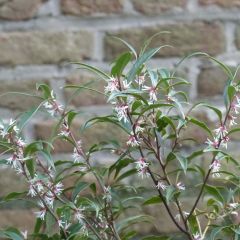
Sarcococca hookeriana var. digyna Purple Stem
- Hauteur à maturité 1,20 m
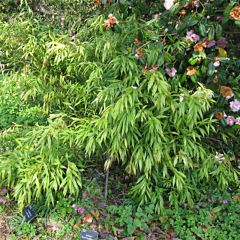
Sarcococca saligna
- Hauteur à maturité 1,40 m
Our ideas for combining sarcococcas :
In the toughest spots (dry soil, roots…) pair them with robust Hardy geraniums, alongside Hellebores and Asarum europaeum.
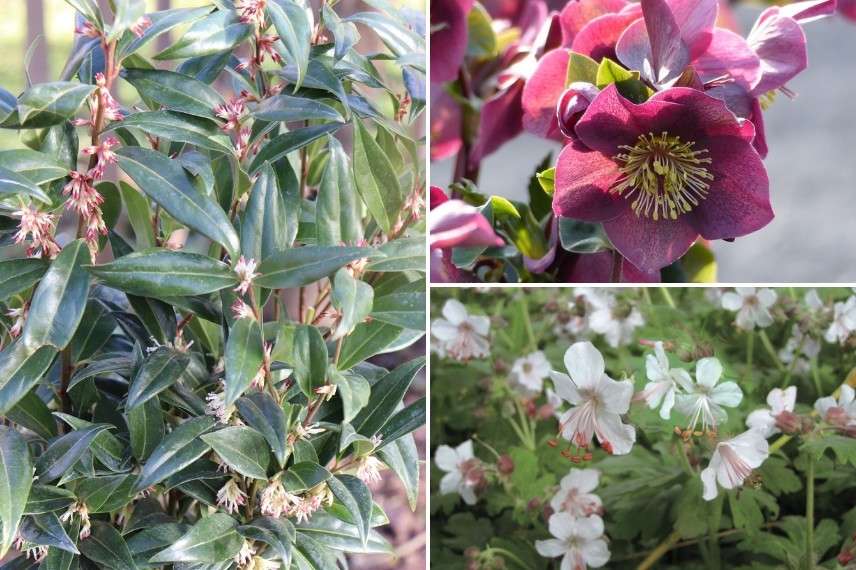
An idea for an association in a difficult spot: Sarcococca ‘Winter Gem’, Helleborus ‘Ice n’ Roses Red’ and Geranium macrorrhizum ‘Spessart’ which will flower a little later in the season
In cooler spots, turn to Japanese maples, Fatsias, accompanied by Hostas and Ferns. Complete with a few Cyclamens and some spring bulbs.
Daphne, an enchanting fragrance
The Daphne is an essential bush for flowering and perfuming shaded areas of garden, even in mid-winter, and their exceptional fragrances are irresistible. Daphnes usually display evergreen, variegated foliage and can therefore be very bright in some varieties. Flowering in small star-shaped white, pink, purple and even yellow blooms is decorative and literally perfumes the garden.
Cultivation :
- Neutral to acidic, humus-bearing soil, fresh but well drained in winter
- Container cultivation possible for most compact varieties
- Hardiness: down to -15°C but some can tolerate down to -30°C
Some interesting varieties :
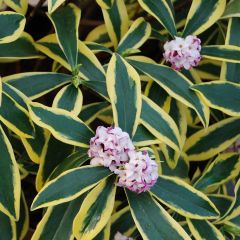
Daphne odora Marianni Rogbret
- Période de floraison March, April
- Hauteur à maturité 1,50 m
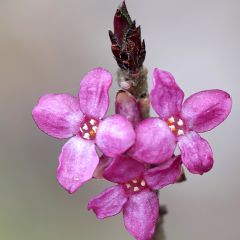
Daphne mezereum var. rubra
- Période de floraison March, April
- Hauteur à maturité 1,20 m
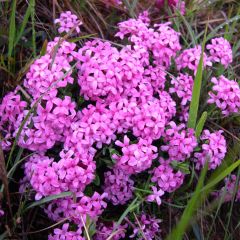
Daphne cneorum
- Période de floraison May, June
- Hauteur à maturité 25 cm
Ideas for pairing Daphne :
The ferns (such as the superb Dryopteris erythrosora with coppery foliage), Hakone grass, Ophiopogon, Heucheras and Rodgersias create a beautiful picture where shapes, textures and foliage colours contrast wonderfully. Complement with perennials with showy blooms such as Hellebores, Alchemilla and Japanese anemones. Early-flowering bulbs accompany Daphne flowering perfectly.
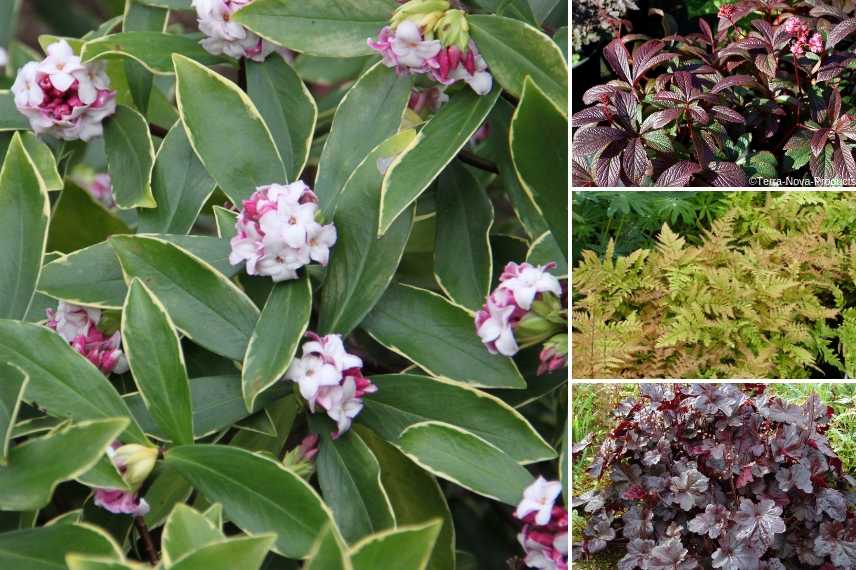
A fragrant, colourful planting idea: Daphne odora ‘Aureomarginata’, Rodgersia pinnata ‘Bronze Peacock’, Dryopteris erythrosora and Heuchera ‘Obsidian’
→ Want to know more about this highly fragrant shade bush? Discover our fact sheet: “Daphne: how to plant, grow and care for it”
Rhododendrons and azaleas, stars of shade gardens!
The term Rhododendrons includes both the ‘true’ rhododendrons and azaleas. This genus offers a very wide choice, with bushes ranging from a few dozen centimetres to several metres. They are true stars of shade and their flowering covers almost the entire colour spectrum: white, blue, mauve, pink, red, yellow and orange. Foliage is no exception: it turns fiery in autumn for deciduous varieties and can be variegated for evergreens. So you are sure to find a rhododendron to suit your garden or terrace.
Growing :
- acid or neutral, humus-bearing, moist but well drained soil
- Can be grown in pots for smaller varieties
- Hardiness: -20 °C
Some interesting varieties :
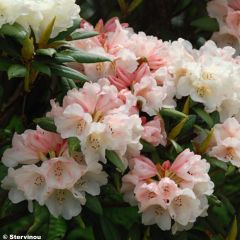
Rhododendron yakushimanum Grumpy
- Période de floraison June
- Hauteur à maturité 80 cm
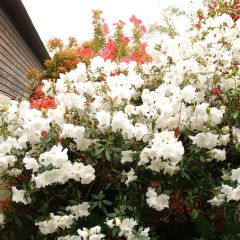
Rhododendron Fragrantissimum
- Période de floraison April, May
- Hauteur à maturité 1 m
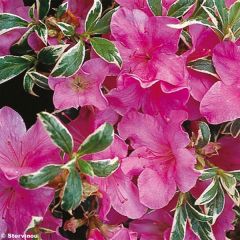
Japanese Azalea Silver Queen
- Période de floraison May, June
- Hauteur à maturité 50 cm
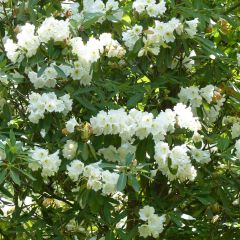
Rhododendron Polar Bear
- Période de floraison August, September
- Hauteur à maturité 5 m
Our ideas for combining rhododendrons and azaleas :
Opt for Pieris with superb foliage and decorative flowering, camellias that, for some varieties, flower when rhododendrons are less showy, or Japanese maples whose graceful leaves take on sumptuous autumn shades. Complete with perennials that dress the base of the bushes such as Japanese anemones, Brunneras, Cimicifugas, Bleeding Hearts, Hostas or Heucheras. Fill gaps with bulbs such as the bluebell, wood anemones or Cyclamen coum.
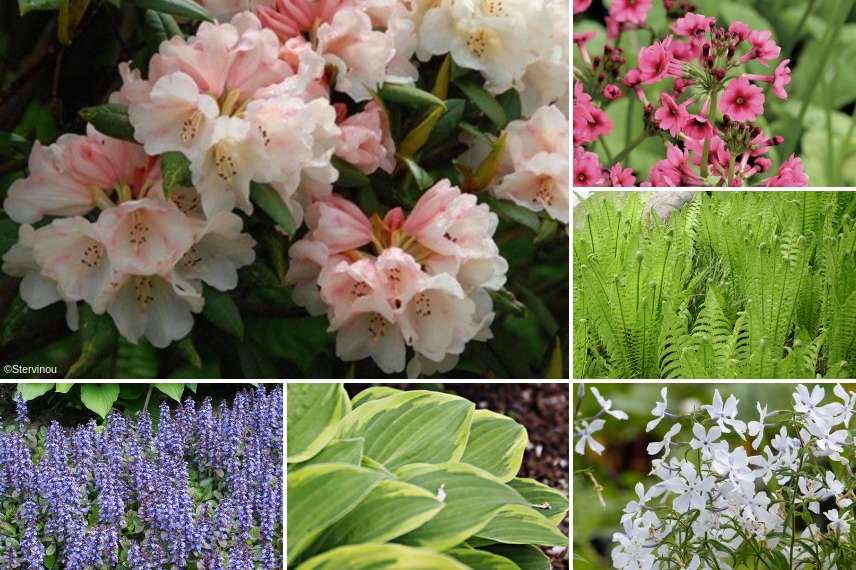
A planting idea: Rhododendron yakushimanum ‘Grumpy’, Primula japonica ‘Miller’s Crimson’, Matteuccia struthiopteris, Phlox divaricata ‘White Perfume’, Hosta ‘Fragrant Dream’ and Ajuga reptans
→ For everything you need to know to grow these heather-soil bushes, discover our comprehensive guide to rhododendrons and azaleas
Viburnum, simple beauty
Although many prefer open, sunny situations, some viburnums behave very well in shade. Their foliage can be evergreen or deciduous and take superb colours in autumn. Flowering, winter or spring, is white, but some varieties offer refreshing pink shades. Small berries, favoured by birds, succeed the flowers.
Cultivation :
- Humus-bearing, cool and well-drained soil
- Pot cultivation reserved for dwarf varieties
- Hardiness: -10 °C to -20 °C
Some interesting varieties :
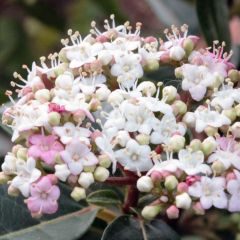
Viburnum tinus Spirit
- Hauteur à maturité 2,50 m
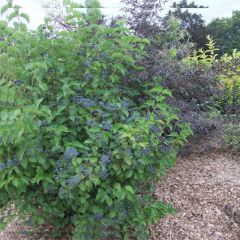
Viburnum dentatum Blue Muffin
- Période de floraison June, July
- Hauteur à maturité 2 m
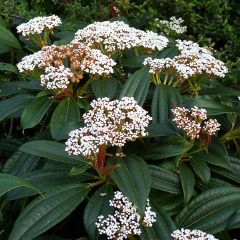
Viburnum davidii - David viburnum
- Période de floraison July
- Hauteur à maturité 1 m
Ideas for pairing these viburnums?
Pair these viburnums with bushes of simple habit and bold colours such as Euonymus ‘Emerald n’ Gold’ or Japanese Angelica Tree ‘Golden Umbrella’. In acid soil, brighten the mix with bell-shaped flowers of Enkianthus campanulatus. Dress the base of your bushes with ferns with dissected foliage, Hellebores and some spring bulbs.
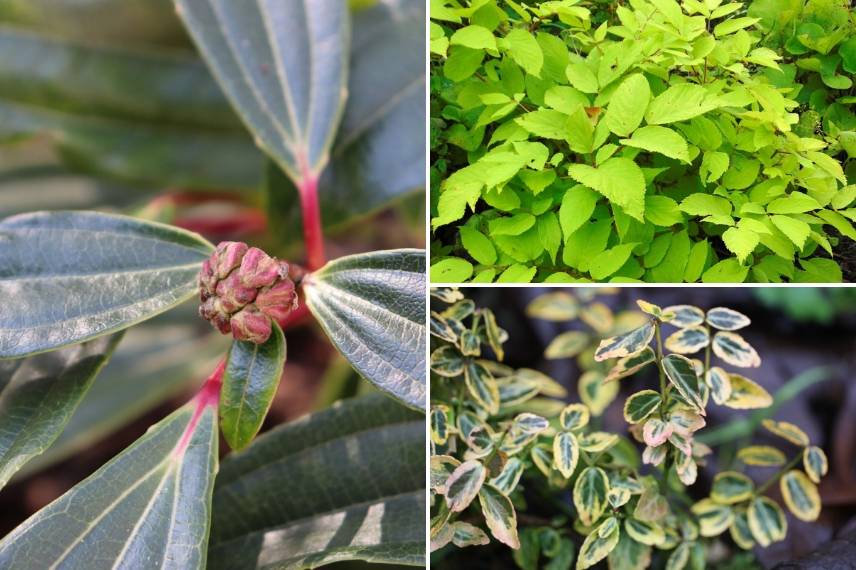
Association idea: Viburnum davidii, Aralia cordata ‘Sun King’ and Euonymus fortunei ‘Emerald n’ Gold’
→ Find everything you need to know and our tips for growing viburnums in our guide: “Viburnum: planting, pruning, growing”
Xanthorhiza simplicissima, sumptuous autumn foliage
Too rarely used, Xanthorhiza, a groundcover bush that could be described as a wise conqueror. Suckering, it is spreading without ever becoming invasive. It produces small brownish‑violet flowers in the heart of spring, followed by star‑shaped fruits much loved by birds. But above all it is used for its remarkable foliage. Dissected, it is green in season, then gradually takes on yellow, then purple and violet tones as autumn advances.
Cultivation :
- Ordinary, fresh, non‑calcareous, humus‑bearing soil. Tolerates clay.
- Hardiness: -15°C
Our ideas for combining Xanthorhiza :
Only Xanthorhiza simplicissima is cultivated in gardens. It is wonderful in a shady spot, near a pond, alongside Kalmia latifolia, Rhododendrons or in front of a Clethra with scented flowering that also displays attractive late‑season colours. To perfect the autumn palette, pair it with dogwoods such as Cornus sericea ‘Cardinal’ which, besides its fiery late‑season hues, remains decorative throughout winter with its wood coloured red. Punctuate the scene with lush foliage of hostas, ferns, Japanese forest grass or Carex. Add colour with flowering from perennials that like cool conditions such as hardy geraniums, Japanese anemones, Siberian bugloss or Campanulas.
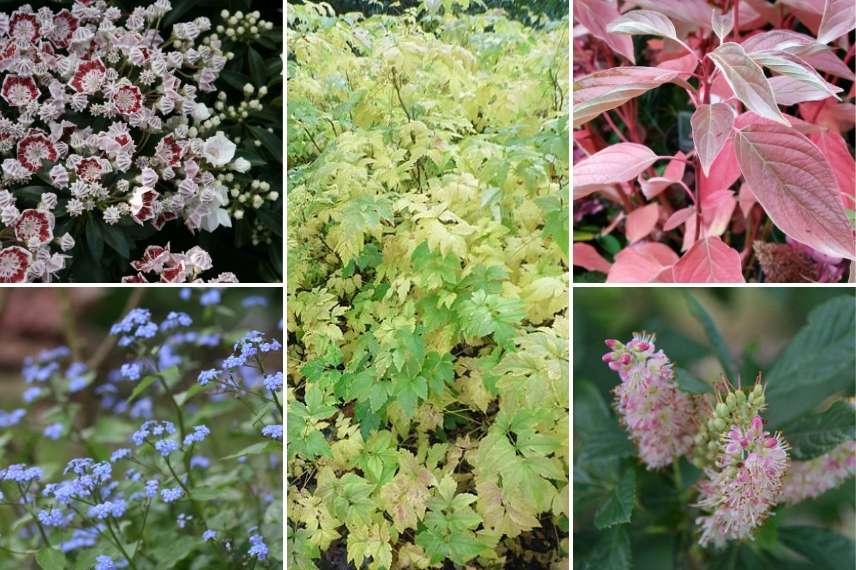
An idea for a combination : Xanthorhiza simplicissima accompanied by Kalmia latifolia ‘Minuet’ and Brunnera macrophylla ‘Jack Frost’ in spring, then Cornus sericea ‘Cardinal’ and Clethra alnifolia ‘Ruby Spice’ in autumn
- Subscribe!
- Contents
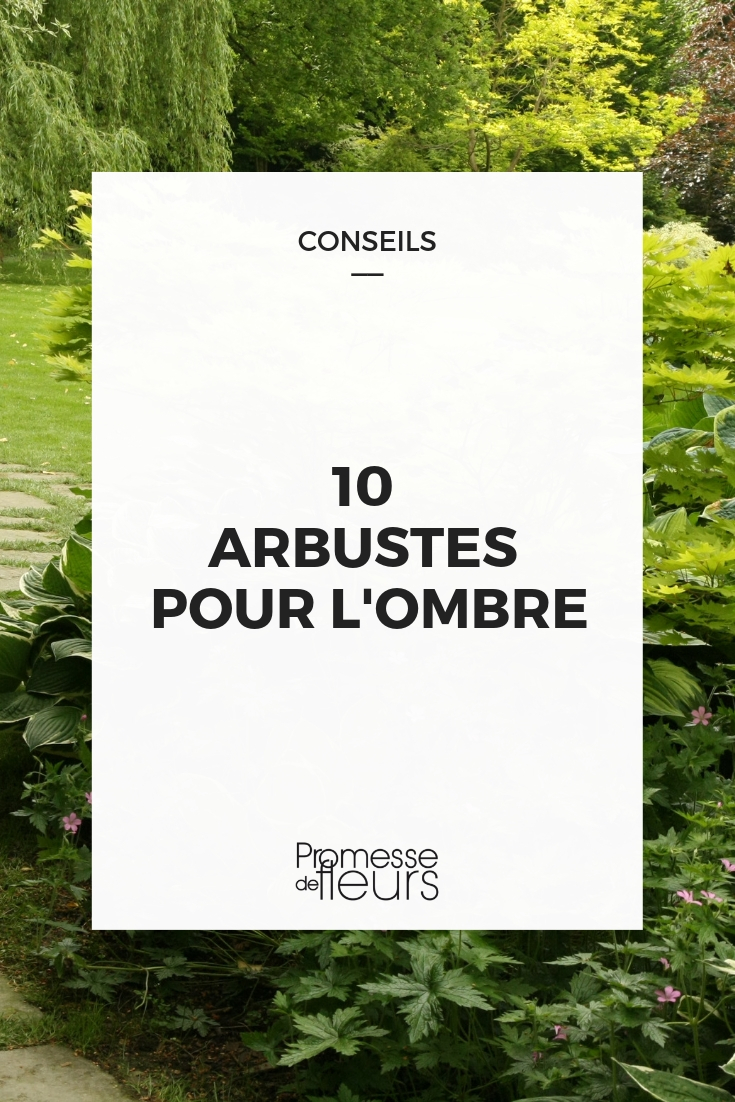































Comments